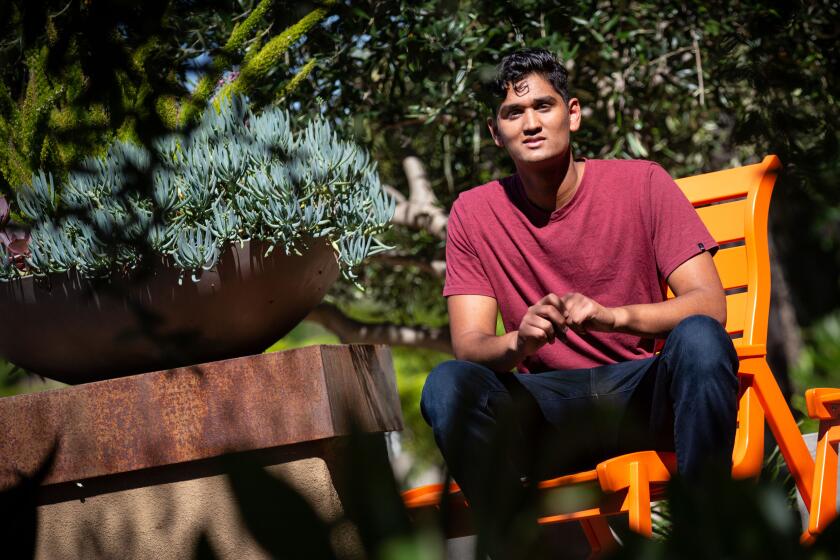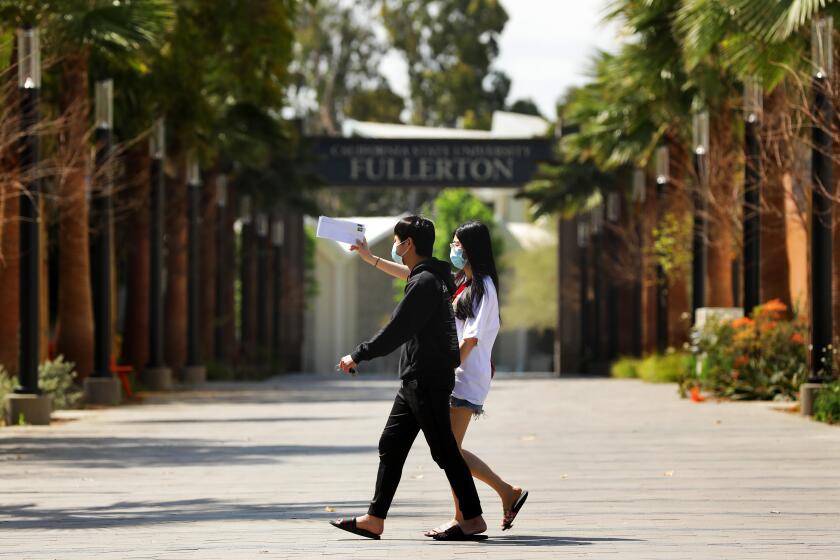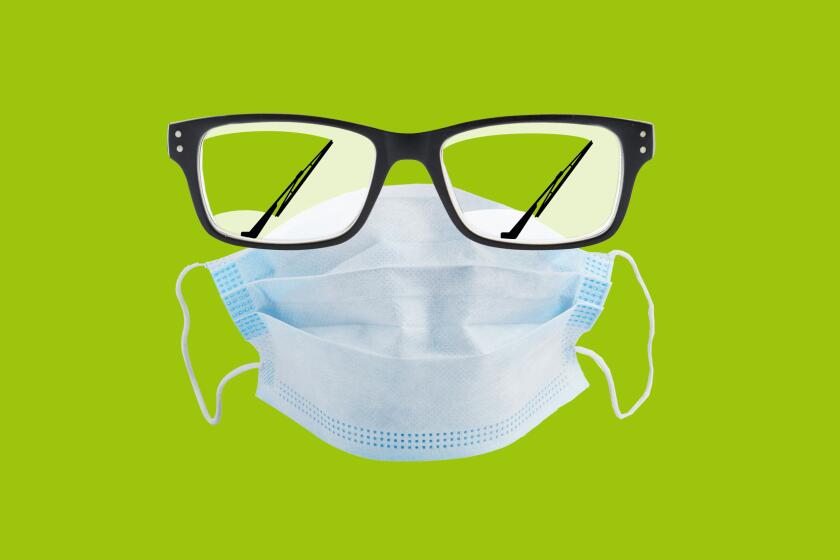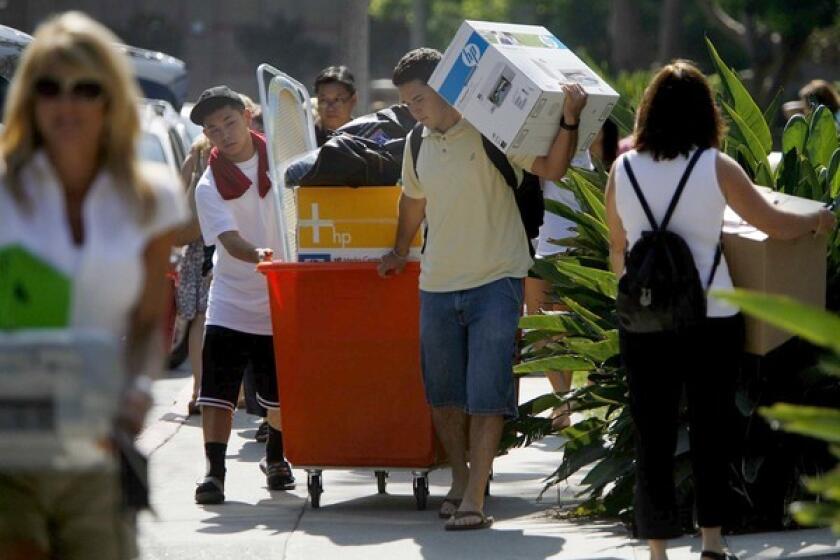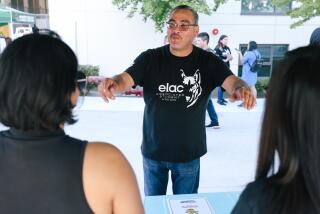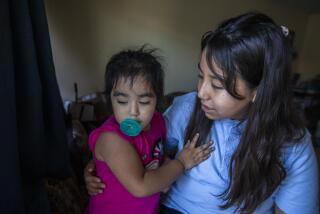As kids go off to college, what’s safe and unsafe?
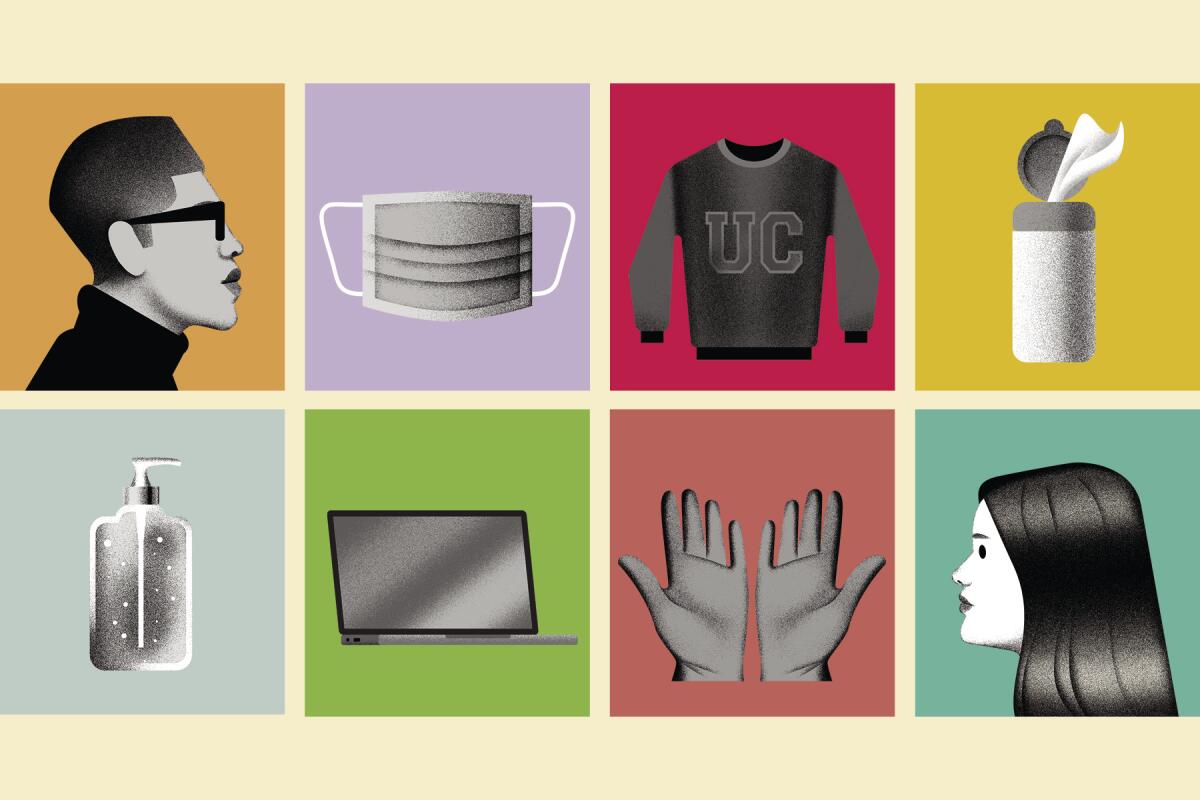
When civil engineering student Itzel Zapata returned to Cal Poly last month, her mother, Rebecca, sent her to San Luis Obispo prepared for the COVID-19 pandemic.
“I packed face masks, gloves and sanitizing wipes,” the Palmdale food services manager said. “We have to be prepared. I’m making sure both my daughters can identify the signs and know to quarantine themselves. I told them, ‘Let’s stay safe, healthy and make sure we stay alive.’”
As coronavirus cases have skyrocketed in California and across the country, Zapata said she is admittedly relieved Itzel is only three hours away and younger daughter Mariah, 18, who missed out on many milestones marking her senior year in high school, will be living at home when her fall classes start at the College of the Canyons in Valencia.
“Mariah cried over prom and graduation,” said Zapata. “Now she can’t live on campus.”

We asked L.A. Times readers to share their most urgent questions about problems troubling us today — including financial struggles and managing anxiety — and will answer them on these pages in the weeks ahead. Many questions focus on kids who should ideally be heading off to college for the fall, and we’re focusing on those queries this week.
Part of the challenge is that no one knows what the new academic year will look like at colleges, especially as guidelines change daily, younger people account for the majority of new cases and a vaccine remains elusive. And with the fall term as soon as a month away, many colleges and universities are scrambling to figure out how to open safely and stay open.
Everyone has an opinion about the value of taking a gap year after high school or during college. For those who do so, it can be a chance for an adventure as well as an opportunity to grow and mature.
The California State University system plans to cancel in-person classes in favor of online learning, and UCLA and USC will resume with mostly online classes.
Many colleges, such as the University of Colorado, Boulder and University of Michigan, will finish in-person instruction by Thanksgiving to reduce exposure to COVID-19 as students travel for the holiday. December classes and finals will then be taken remotely.
This much is clear: Students who choose to live on campus can expect temperature checks, single dorm rooms, contact tracing, even liability waivers. Rice University in Houston is building outdoor classrooms to assist with social distancing. Students at Harvey Mudd College and Purdue will be required to abide by a health honor code.
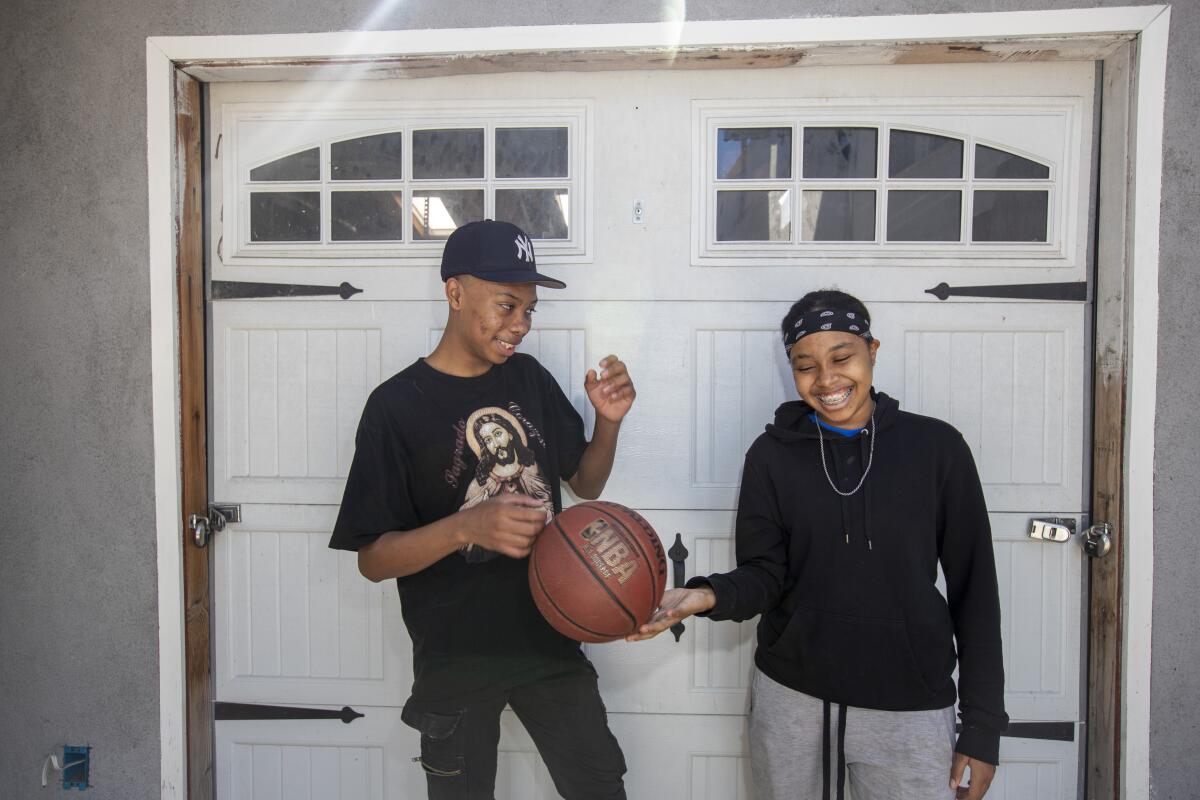
While many students will not be required to take in-person classes, numerous incoming nonlocal freshmen, like Brianna Malcolm-James, 18, will be guaranteed on-campus housing.
“I’m excited because I get to go to college in person,” Malcolm-James said of attending Chatham University in Pittsburgh where she hopes to play basketball. “I am nervous because I’m leaving home for the first time and going to another state by myself. But I want to go to school. I don’t want anything to be canceled. Classes will be smaller, and there will be checkups every day. The dining hall will offer takeout food. I’m ready. I’m looking forward to playing basketball again.”
Last school year, you might have spent weeknights in a study room with poor circulation, surrounded by friends as you crammed for exams.
Her twin brother, Bernard, will be taking online classes at Golden West College in Huntington Beach.
“I’ll admit that I kind of like the thought of online classes,” Bernard said. “I can just focus on school and transferring to a university in two years.”
Wearing masks will help minimize the spread of COVID-19. Here’s how to do it right.
Olivia Campbell, a 21-year-old environmental sciences major at UC Berkeley, considered taking a gap year after finishing her junior year online.
“But where am I going to find a job?” she asked. “I decided to push through.”
Campbell anticipates her classes will be fully remote for the fall, an arrangement that leaves her feeling both daunted and relieved, especially after a recent outbreak of COVID-19 cases on campus. “I went from living in a co-op with 40 people to a house with four roommates. We are all taking this seriously. Even if I’m in a small class, I don’t know that I want to sit in a room with 20 students on campus. I’d rather see one close friend and have my exposure be limited to that one person.”
Pardis Sabeti, professor of immunology and infectious diseases at Harvard, predicts the coronavirus will be the elephant in the room when students return to campus. “It can potentially make students feel that their school year is ‘less than,’” Sabeti said. “Nevertheless, my motto is that the school year should in fact be a ‘more-than’ year and one they all remember 20 years from now as an experience-rich time when they learned more than they ever had before.”
Even with Sabeti’s optimism, it would be hard to find a more difficult time to consider going back to school than during a pandemic.
Here, experts answer six of parents’ most pressing questions in regard to in-person learning on campus this fall.
1. Everything is changing so quickly. What should we watch for?
Alvin Tran, assistant professor of public health at the University of New Haven, encourages parents to monitor the COVID response plans of their child’s college or university, which will vary by school, county and state.
“It’s important for students and their parents to have a conversation about how their school plans to prevent the spread of infection on campus,” Tran said. “Everyone should be aware of the protocols, including what steps students should take should they get sick. Trust that schools are weighing many safety protocols for the upcoming semester, and officials might not make a final decision until sometime in August. Going to college should still be an exciting time for students. They should be excited but also vigilant this fall.”
Parents should keep in mind that many universities, such as Tran’s, are requiring all returning students, staff and faculty to have proof of a negative COVID test prior to returning to campus. Additionally, many students will be tested upon arrival and quarantined until their status is confirmed.
Last school year, you might have spent weeknights in a study room with poor circulation, surrounded by friends as you crammed for exams.
2. Is college move-in day a risk?
Unfortunately, Yes.
“One of the best ways to limit the spread of COVID-19 and lower the risk of becoming infected is to defer all nonessential travel, especially air travel,” said Robert Quigley, an infectious disease and travel expert and regional medical director of International SOS and MedAire. “Unfortunately, this includes traveling to assist your children on move-in day at their campus.”
Quigley recommends checking in with schools, which all post COVID-19 updates online, prior to booking travel arrangements as many schools will have a limit on who can be on campus. “A recurrent outbreak could occur at any time at the destination or transit location and could escalate rapidly, so if you are required to travel, be sure to monitor bans, quarantines and similar restrictions required at the destination and subsequent destinations, including return home, prior to booking accommodations,” he said. “A growing number of states and countries have imposed public health measures to reduce spread of the virus, and they may be enacted with little or no warning. These measures can include but are not limited to restrictions on movement, bans on mass gatherings, closure of some nonessential facilities and community lockdowns. These measures should be taken into consideration prior to departure as well.”
3. What is the real story on testing, when results take so long to receive?Doesn’t that pose a significant risk to the colleges’ return-to-school plans?
According to Sabeti, all return-to-school programs will need rigorous testing protocols.
“What will prove very important is a community-based effort to develop an ability to find and track potential cases very quickly,” Sabeti said. “If tests are limited, it will be critical to use them most efficiently by incorporating contact-tracing approaches, such as smartphone-based applications. Such an approach could alert school leadership when anybody in a child’s family or contact network exhibits symptoms and then quickly identify the necessary public health steps and provide the relevant support or guidance for the affected community. We must also acknowledge that if the infection ever reaches the school, it could spread like wildfire.”
Ultimately, Sabeti said, colleges should create a cocoon around the school and a buffer to understand how infections reach school grounds by way of students and staff.
“Given everything that is going on, it sounds highly infeasible to bring schools back,” she said. “However, one benefit of preparing for schools’ return in the time of COVID-19 is that improving testing efforts in the communities that schools lie within and expanding support options for that outside perimeter actually serve the health of both schools and communities. It’s mutually beneficial to us all, to strengthen surveillance and testing around the schools as well as develop an ability to conduct rapid detection and thoughtful surveillance within schools.”
Even though she really misses her college, and wants out of our house, my daughter decided the risks outweigh the benefits and is taking her classes from home.
4. What if students become ill?
“Colleges and universities should be communicating frequently with students and staff prior to opening campuses and on an ongoing basis after opening day,” said Quigley. “This consistent and transparent communication should include information around preventive measures for on-campus activities such as face masks and hand washing/sanitizers, available medical resources as well as insight on what to do should a student start to experience symptoms of COVID-19, keeping in mind many students may be infected and yet be asymptomatic. Institutions should also implement ways for parents, students and faculty to voice concerns and ask questions prior to and in real time as it relates to the pandemic, as it is likely details will change, and there will be questions.”
Sabeti agreed. “All schools should have separate locations where people are placed and cared for if they are suspected to be COVID-positive but still have not been tested, who should be isolated individually, versus for those who are confirmed to be COVID-positive.”
Sabeti recommends group housing in a dorm-like setting for COVID-positive students, where they can support one another as they recover.
“Ideally, we want to provide care and keep other students safe, without fully isolating infected students,” she said.
5. Can contact tracing help bring kids safely back to school?
“Contact tracing is Disease Prevention 101, meaning it is an extremely effective tool in curtailing the risk of community transmission of an infectious agent, such as COVID-19,” said Karl Minges, director of the Master of Public Health Program at the University of New Haven.
“Many states, towns, public and private institutions have initiated their own contact tracing efforts, largely due to the absence of a federal response,” Minges continued. “This might mean that a parent who works at a local university may be tested for COVID-19, and if positive, the university can either initiate their own contact tracing efforts or work with the local or state public health department. However, in schools to date the CDC guidelines do not recommend teachers, staff or children to be tested. If they are not tested, then contact tracing efforts cannot occur, which removes the benefits of contact tracing. This is not a chicken-or-egg conundrum; it is putting the cart before the horse. If school districts implemented testing efforts in either a pooled sample or population basis, then contact tracing can absolutely improve the health and safety of school-aged children.”
6. How can we get students to take the pandemic seriously?
Will students adhere to public health guidelines of wearing face masks, maintaining social distance and washing hands? Sabeti said it’s important to keep students engaged and make them a part of the solution prior to an outbreak. Students know, she said, that their ability to stay on campus depends on the campus remaining COVID-free.
“There is really no better time than now to learn statistics, epidemiology, clinical medicine and government, as critical parts of understanding an outbreak,” she said.
In addition to developing an outbreak simulation system at a charter school in Florida, Sabeti is working on a “Huddle” symptom reporting app and dashboard through which you can identify who is in your community and detect viruses that could be circulating. (They are both going live with Colorado Mesa University this week).
“Ultimately, we need to focus on aligning incentives so that we can really make students a part of the solution,” Sabeti said, “There is truly no better moment in time to engage everyone in ending this pandemic. Huddle and our outbreak simulation system are just two examples of how we can apply new technological methods to educate ourselves and our students and work together to find solutions now and for the future.”
More to Read
Sign up for The Wild
We’ll help you find the best places to hike, bike and run, as well as the perfect silent spots for meditation and yoga.
You may occasionally receive promotional content from the Los Angeles Times.
